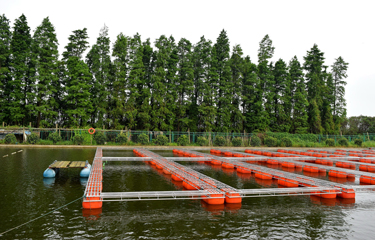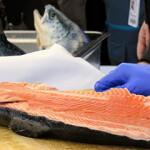Seeing opportunity at home, China’s aquaculture investors shift gears

China’s longstanding policy goal of obtaining more seafood from overseas may be changing.
The country's commitment to investing in global aquaculture projects has gone tepid in the past year, despite a policy set by its Ministry of Agriculture to increase China’s international cooperation in aquaculture, with the goal of shifting away from large-scale domestic aquaculture production and toward sourcing more domestically-consumed seafood abroad.
China’s lending to developing countries has been dramatically scaled back by its two policy lenders, China Development Bank and Export Import Bank, from USD 75 billion (EUR 62.1 billion) in 2016 to USD 4 billion (EUR 3.3 billion) in 2019, according to a research team at Boston University that tracks China’s lending to developing nations. Data compiled by the American Enterprise Institute has also shown a drop in the numbers of Chinese workers in Africa back to 2009 levels, as demand and prices for commodities fell. The bulk of the workers are now working on infrastructure projects in Algeria, Angola, and Nigeria.
In the past decade, China has assisted developing countries with aquaculture projects through training programs delivered by the China Academy of Fishery Sciences. But it may have been decided that overseas aquaculture production is no longer economical for supplying the domestic Chinese market, according to Huang Jie, director general of the Network of Aquaculture Centres in Asia Pacific (ENACA).
“Risk and cost are the key worries for private investors looking at China’s aquaculture sector,” Huang told SeafoodSource.
China’s decision-makers when it comes to commercial investments in aquaculture are beginning to see more potential in domestic projects, as local operations enhance performance due to both improved regulations and better training and information-flow across the value chain, Huang said. As a result, modern aquaculture projects have drawn significant investment in China recently and mariculture has become an investment theme for major Chinese state-owned companies.
“Aquaculture is still one of the biggest capital-attracting industries,” he said. “The risks mostly include diseases, climate disasters, market fluctuations, and policy instabilities, etcetera. The costs mostly include land, feed, and labor costs. So, if policies will help to solve those issues, it will greatly promote the attraction for private investors.”
A refocusing on efficiencies at home comes as many indicators suggest China has scaled back lending to developing countries and has grown less enthusiastic about big-ticket investments abroad. Through its signature Belt and Road Initiative (BRI), China had pledged CNY 1 trillion (USD 154.5 billion, EUR 128.2 billion) to countries covered by the blueprint – including much of Southeast and South Asia, Africa, and Eurasia. But worries about debt defaults is tempering Chinese ambition in so-called BRI countries and may lead to a pull-back in funding.
The retrenchment of Chinese investment could be bad news for numerous seafood companies that have been seeking Chinese investors. In Nigeria, the Adoni Fishing Park, comprised of a 5,000-hectare free trade zone that the country’s government has backed for its potential to reduce Nigeria’s dependence on imported fish, is at risk. Likewise, Jimmy Urrutia, who is selling a shrimp farm in Mexico, and David Singh, who owns a tilapia farm in Trinidad incorporating four hatcheries, a feed mill, and 65 one-acre ponds, have also struck out in finding Chinese buyers or investors.
In Africa, the continent where Chinese investment in aquaculture have been most significant, local governments have struggled to repay aquaculture-related loans from China and have pushed to restructure their terms. At an annual gathering last year of the Forum on China-Africa Cooperation (FOCAC), President Xi Jinping and his Senegalese counterpart Macky Sall didn’t announce a single deal – which has never happened in the past decade of FOCAC meetings.
William Leschen, head of Casammak Aquaculture, which advises on African and Asian aquaculture, said Chinese officials may have done the math and realized that financially, it may make more sense for China to fulfill its aquaculture needs at home.
“At the moment, the production price for tilapia and the management of various African production systems are still much higher than for those in China,” Leschen told SeafoodSource. “There is no point [Chinese investors] producing in the likes of Ghana or Zambia now to import back to their own growing middle-class markets across China.”
Leschen’s analysis is supported by a look at recent prices from Chinese wholesale markets. Tilapia was retailing at an average CNY 7.00 (USD 1.12, EUR 0.91) per kilo this week at wholesale markets in Yangjiang, Guangdong Province, a key production base for tilapia. And at the Wuhan Baisha wholesale market – a hub in China’s freshwater aquaculture belt of Hubei Province – mid-sized catfish are selling this month at CNY 9.40 (USD 1.50, EUR 1.22) per kilo, with carp at CNY 15.80 (USD 2.37, EUR 2.05) per kilo for the largest fish.
“It’s different if you’re saying they want to come into Africa to produce for the African market,” Leschen said. “Prices per kilogram [in Africa] are much higher at USD 2.50 [EUR 2.06] or USD 3.50 [EUR 2.88] – even USD 4.00 [EUR 3.30] per kilogram are not that uncommon across many African countries.”
Demand at these prices is “far from being met” in African urban areas like Accra, Nairobi, and Kampala, said Leschen, who also runs the online SARNISSA information exchange for African aquaculture. He pointed to prices for tilapia rising as high as USD 9.00 (EUR 7.45) per kilo in Luanda, the capital of Angola.
Meanwhile, China’s demand for imported seafood has been highlighted by figures from the country’s Agriculture Ministry in its latest Fisheries Yearbook, a compendium of 2019 data. Overall seafood production, at 64.5 million tons in 2019, sunk to the same level it was at in 2014, down from the 2018 total (64.7 million tons) and from 2017 (69.4 million tons).
Photo courtesy of tanakornsar/Shutterstock






Share